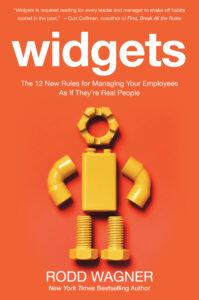Think your people are your greatest asset?
Do you survey your employees but ask the wrong questions?
Is corporate engagement one of your goals?
Widgets, FTE’s and Assets
What I think I love most about Rodd Wagner’s new book WIDGETS: The 12 New Rules for Managing Your Employees As If They’re Real People is his clear, unambiguous writing that calls it like he sees it. He upends common practices and wisdom, throwing out what you know and replacing it with what just makes sense. Our conversation is likely to change your position on a few subjects and have you rethink your practices. It did for me.
Why did you call the book “Widgets”?
If you spend enough time at enough companies, the bad terms used to refer to people start to accumulate. “Human capital.” “Full-time equivalents” or “FTEs.” “Headcount.” “Aprons” at a home improvement store. “Blue shirts” at Best Buy. I could barely contain my shock when leaders for one temporary staffing firm referred to the people they place as “inventory.” And the department responsible for people? In most companies, it’s called “Human Resources.” At one company, a mass layoff is called a “resource action.”
These are euphemisms, and euphemisms are most dangerous when used to refer to people, because they make it easier to disregard that we are talking about someone’s son or daughter, brother or sister, and they deserve the respect and dignity of being referred to as people. I used the title “Widgets” to take a hard whack at these bad habits and all the dehumanizing practices that flow from that perspective.
Lather. Rinse. Repeat.
What is wrong with many employee engagement efforts today?
Employee engagement is in a rut. It’s become hackneyed. It’s routinized.
Commission a survey. Beg people to participate. Get the results back. Distribute scorecards. Train some trainers; unleash them on the company. Cajole the CEO into using the word “engagement” in his next speech. Ask managers to do some team sessions, which maybe half will do before tucking the forms in a desk drawer. Leave the way managers are selected, coached, supported, and held accountable untouched. Let the executives feel good that they checked the employee engagement box. Go quiet for 9 or 10 months until it’s time to start the Sisyphean cycle all over again. Lather. Rinse. Repeat.
 But the most pernicious problem with engagement initiatives today is the way some consultancies and companies talk about the people who are neglected and, when the survey comes around, tell the truth. So-called “disengaged” employees are vilified, their motivations and character questioned. They’re said to be “more or less out to damage their company” or trying to undo what the more “engaged” accomplish. Our research contradicts these assertions that those who are most frustrated are some kind of “cancer” inside the organization.
But the most pernicious problem with engagement initiatives today is the way some consultancies and companies talk about the people who are neglected and, when the survey comes around, tell the truth. So-called “disengaged” employees are vilified, their motivations and character questioned. They’re said to be “more or less out to damage their company” or trying to undo what the more “engaged” accomplish. Our research contradicts these assertions that those who are most frustrated are some kind of “cancer” inside the organization.
Of course, recognizing that they will be suspect if they give low marks to their company, many employees have realized it’s career suicide to tell the truth. So they don’t. Who would under those circumstances? “Just mark five to survive,” one admin advised her colleagues. In many places, it’s now difficult if not impossible to even get a true measure of engagement. That’s the mark of a fundamentally flawed and broken system.
Inside the Head
Getting inside their heads is your first rule. It’s individual; it’s unique; it takes up significant time. And yet, it’s the most important of all. Would you share why this rule is the first?
I’ve been fielding and analyzing employee surveys and other data from more than a decade-and-a-half. Every time I plot the numbers on a new study, the first thing that strikes me is the massive range in individual responses. You simply cannot predict how a person will feel about his or her job based on generation, age, gender, race, tenure, industry, company, or any of the other group statistics that are used so often to stereotype employees.
Engagement is an individual phenomenon. Everything – how much money people want, what they consider a cool place to work, how they like to be recognized, what they envision for their future – is unique to that person. Therefore, applying all of the other New Rules depends on first understanding that one person and responding to his or her personality and ambitions. This is the reason that every good piece of research on employee engagement finds that a person’s direct supervisor is one of the key players. That manager is in a unique position to know the employee well and match him or her with the resources and opportunities inside the company.
Best Friends at Work
Having a best friend at work appears in most surveys, and we repeatedly hear that it is critically important. You argue otherwise. Help us understand.
First, asking about friendships – particularly sticking your nose in an employee’s “best” friendships – is quite intrusive when the relationship between company and worker is increasingly transactional. One week you’re asking about their best friends, the next week you’re sending a few thousand of them home with severance packages. So if they either had best friends at work or were the best friends of someone still there, you’ve opened yourself to some well-founded criticism that you abused their trust.
More important, in the studies my teams and I have conducted, the “best friend” concept does not hold up well in driving results compared with more
business-related questions such as trust in leadership, perceived future of the company, and collaboration. Asking about those is your business and is better connected to your results than asking what The Washington Post once called a “high school” popularity question.
What can a professor teaching more on the left side of the classroom teach us about motivating teams?
A couple times during my academic career, when the instructor was late, I instigated a little experiment with the rest of the class. We agreed that once the professor arrived and started to lecture, we’d pay rapt attention the further he was to the left and seem increasingly disinterested the further he was to the right.
It takes about the length of the class period for the effect to play out, but within about 45 minutes you can have him almost plastered against the left wall. He doesn’t really even realize why he’s favoring that side of the room, but his brain is getting more of the reward chemical dopamine because of the reinforcement he gets on the left side.
The business lesson is that what gets recognized gets repeated. We’re social creatures, and we crave the reinforcement that says we’re doing a good job. Just as the professor will slowly gravitate toward the left side, employees will gravitate towards tasks, managers, leaders, and even companies where they get that all-important recognition for their best work.
Let Them Lead
One of your rules is “Let Them Lead.” Give employees a say in how work gets done. Why is this so important? What are the best ways to make this rule a reality?
It’s well established in the research on engagement that employee “voice” is a powerful motivator. People are far more committed to ideas that are at least partially theirs. We decided to dial it up a notch, asking about whether people have a chance to take the lead in their jobs, and analyze to see if those opportunities are more motivating than simply feeling like their “opinions seem to count.” They are. Non-supervisory employees become exceptionally committed to projects for which they have leadership responsibilities.
The best way to put this in action is to look for projects or workgroup situations where the reins can be handed to someone on the team. It has to be a deliberate decision – a situation chosen by the manager as a good challenge without setting up the employee to fail. And it means the manager, rather than being relieved of that responsibility, may end up spending more time coaching his or her employee. But it’s an investment in the employee that he or she will appreciate and that makes him or her that much better at taking on additional responsibility in the future.
Rodd's 12 Rules
Rule 1: Get inside their heads
Rule 2: Make them fearless
Rule 3: Make money a non-issue
Rule 4: Help them thrive
Rule 5: Be cool
Rule 6: Be boldly transparent
Rule 7: Don’t kill the meaning
Rule 8: See their future
Rule 9: Magnify their success
Rule 10: Unite them
Rule 11: Let them lead
Rule 12: Take it to the extremes
Employee Loyalty
What have you learned about employee loyalty?
Loyalty is the natural state of most employees. Most are grateful for their jobs – particularly after the Great Recession – and they want to deliver well for their employer. Most don’t plan on quitting unless things become quite miserable. Most will keep plugging along even when they are not getting much of what the New Rules research says they should be getting.
Their expectations are reasonable. “Give me a supportive manager.” “Don’t use fear to push me.” “Pay me fairly.” “Don’t work me to death.” “Let’s try to make work fun.” “Tell me what’s going on.” “Don’t destroy my sense of meaning.” “Care about my future.” “Recognize my hard work.” “Set us up for collaboration.” “Give the chance to lead.” “Give me a sense of accomplishment.”
This means that in the vast majority of situations, if an employee is not giving high marks to the job, it’s the fault of the leaders and managers, not the employee. Because people are so reciprocal, a company gets the engagement (and loyalty) it deserves. Because engagement is so connected to performance, a company also gets the performance it deserves.
Happiness is the Truth
Comment on happiness as a corporate goal.
There’s a weird line of argument in the engagement industry that employee happiness should not be the goal because you will essentially spoil your employees. Instead, according to this line of attack, people should be “engaged,” by which they mean almost obsessed with their work. Framed in that way, employee engagement is really just a big trick, a way of making the employee work harder without getting very much in return.
Most employees don’t ever use the word “engaged.” They want to be happy – happy in their jobs and happy in their lives. They’ll go to great lengths for a company that has as one of its goals to make them happy. That’s the bargain, the true unwritten social contract: Work hard for us and we’ll work to make you happy here. It’s really just that simple.
When I set out to write Widgets, I did not anticipate writing about happiness. I was far more focused on the power of each individual rule. But once I spent some time reviewing what the anti-happiness crowd has been arguing, I was appalled. I became stridently anti-anti-happiness, which is, as it turns out, pro-happiness. In any case, follow all 12 New Rules and you’re at about the five-yard line of making people happy, so just push it in for the touchdown. It makes for a nice legacy.
Why do you give free access to the New Rules index on your website iamnotawidget.com?
It’s always bothered me that traditional engagement surveys don’t give an individual any feedback about what his or her answers said about where they stood in the grand scheme. I’ve been looking at people’s individual engagement levels in client records for 15 years. It seemed only logical to give people access to their own information.
Once we’d made the investment to build the metrics and reporting mechanisms for our clients, the incremental expense of opening it up to any individual was not that large. I wanted to be able to do something for the person who doesn’t want to wait six months for the next company survey or whose employer might not pay attention to these issues. And let’s face it, no one is going to take a greater interest in a person’s situation than that person himself or herself. So they need that information.
WIDGETS: The 12 New Rules for Managing Your Employees As If They’re Real People

